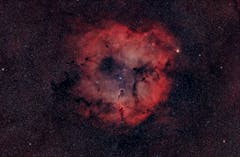Astronomik H-alpha 12nm CCD MaxFR Clip-Filter EOS XL
MaxFR Astronomik photographic narrowband-emission line filters for fast optical systems.
There is an ever-growing demand for filters suitable for extremely fast optical systems like Celestron’s RASA and the Epsilon Astrographs made by Takahashi.
Our novel MaxFR emission line filters are suitable for very fast focal ratios. The Astronomik MaxFR series of narrowband emission line filters is perfectly matched to the requirements of astronomical deep-sky imaging with fast optical systems. For the three most important emission lines of oxygen (OIII), hydrogen (H-alpha), and sulfur (SII), you may select filters with either 12nm or 6nm Bandwidth (FWHM).
MaxFR OIII-CCD filter
6nm and 12nm FWHM
MaxFR H-alpha-CCD filter
6nm and 12nm FWHM
MaxFR SIII-CCD filter
6nm and 12nm FWHM
Highest transmission:
Our new MaxFR filters are designed to work perfectly with fast optical systems. The built-in MFR Coating technique provides the best out-of-band blocking possible across the entire range of wavelengths from UV up to IR! Enjoy extremely high contrast, minimized stray light, no halos, and needle-sharp stars. Astronomik MFR narrowband-emission line filters offer the best quality data to process into awesome final images!
- For 12nm MaxFR filters: Unlimited usability from f/1.7 to f/8, and about 85% of maximum transmission at f/1.4.
- For 6nm MaxFR filters: Unlimited usability from f/2.2 to f/8, with about 90% of maximum transmission at f/2.
Imaging with Narrowband-Emission Line Filters
If you observe from light-polluted areas, imaging with narrowband-emission line filters is an excellent way to take great images as most types of light pollution can be blocked effectively! Typically, an H-alpha filter should be your first step into astrophotography. With an H-alpha filter, you can capture deep and contrasting images even under heavy light pollution or a bright full moon! OIII filters allow imaging of greenish-blue structures, ideal for planetary nebulae and star-forming regions. The SII filter completes your HSO-set, allowing you to process images like those from the Hubble Space Telescope.
Quality Aspects of Astronomik MFR Narrowband-Emission Line Filters:
- MFR Coating: 12nm filters work for instruments down to f/1.4, 6nm filters work down to f/2.
- High-Quality Substrate: Astronomik filters are made with stress- and striae-free, optically polished glass with ultra-thin layers.
- Parfocal Filters: All Astronomik filters are parfocal, ensuring no shift in the focal plane when changing filters.
- Durability: Scratch-resistant, moisture-resistant, and guaranteed to meet specs even after years of use.
- Integrated Blocking: Blocks unwanted light in the entire spectral range from UV to IR, no additional UV/IR-blocker needed.
- Available Sizes: 1.25" up to square 50mm x 50mm filters.
- Delivered in a high-quality protection & storage box, and covered by a 10-year guarantee.
FAQ - Narrowband-Emission Line Filters:
Which is the best FWHM, 12nm or 6nm?
There is no universal right or wrong answer. If you have a camera with extremely low dark current and effective cooling, 6nm filters offer better contrast and star reduction. 12nm filters are the best choice for DSLR cameras and dark-current-limited cameras, while 6nm filters are better for sites with extreme light pollution and weak objects requiring maximum contrast.
How much does exposure time increase?
You don’t have to expose for longer, but you can! The high transmission ensures nearly all emission line photons reach the sensor. However, blocking unwanted light allows you to expose longer if needed to capture faint structures.
Filter Selection:
Choose the matching size and FWHM for your setup to get the right filter for your needs.
















